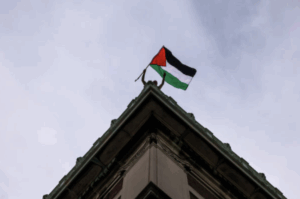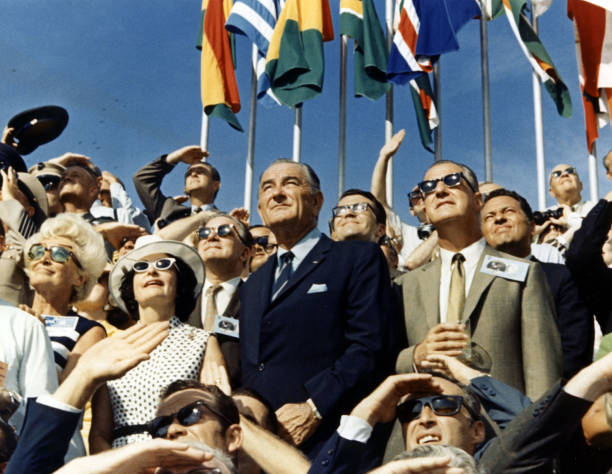Before the Moon — How the Cold War launched us skyward
To understand Apollo 11, we must start not on the Moon, but in postwar Earth, where two superpowers emerged from the ruins of World War II — the United States and the Soviet Union. Locked in ideological conflict, each sought global influence through military power, economic aid, and cultural supremacy. The arms race dominated headlines — but soon, the Cold War expanded upward.
In 1957, the USSR shocked the world by launching Sputnik 1, the first man-made satellite to orbit Earth. It was a symbolic and strategic coup. The Soviets had beaten the Americans into space. U.S. newspapers called it the « Sputnik Crisis »; school systems were overhauled, and defense budgets skyrocketed.
The Soviet space program pushed further:
- In 1959, Luna 2 became the first human-made object to hit the Moon.
- In 1961, Yuri Gagarin became the first human in space — orbiting Earth in Vostok 1.
The U.S., caught off guard, responded with a sense of urgency — and humiliation. NASA, established in 1958, was given the resources and mandate to reclaim technological leadership. But there was more at stake than rockets.
As the two nations raced to the heavens, the Moon became a stand-in for Earth-bound ideology: capitalism vs. communism, democracy vs. dictatorship. Whoever got there first would claim not just lunar dust, but the future of civilization.
Kennedy’s gamble — A promise to reach the impossible
On May 25, 1961, just 20 days after America’s first manned spaceflight (Alan Shepard’s brief 15-minute hop), President John F. Kennedy addressed a joint session of Congress with an audacious goal:
“I believe that this nation should commit itself to achieving the goal, before this decade is out, of landing a man on the Moon and returning him safely to the Earth.”
It was aspirational, perhaps even reckless. At the time, the U.S. had no heavy-lift rocket capable of reaching the Moon, no lunar lander, no experience with space rendezvous, and no deep-space communication system. But Kennedy’s vision wasn’t just about engineering — it was about prestige, morale, and global perception.
The result was Project Apollo: the most ambitious and expensive peacetime initiative in American history. Over the next eight years, the U.S. would spend $25.4 billion (equivalent to over $160 billion today), employ more than 400,000 scientists and engineers, and design machines unlike anything humanity had ever built.
While critics derided the program as a political stunt or an irresponsible extravagance, others saw it as a beacon — proof that peaceful competition could elevate humanity rather than destroy it.
The astronauts who carried Earth on their shoulders
By 1969, NASA had tested the hardware, flown men around the Moon (Apollo 8), and rehearsed lunar approaches (Apollo 10). The final step: Apollo 11, launched on July 16 from Cape Kennedy, Florida, aboard the mighty Saturn V.
The crew were highly trained, but far from ordinary:
- Neil Armstrong: quiet, methodical, and trusted — a test pilot with nerves of steel.
- Buzz Aldrin: technically brilliant, outspoken, and the first astronaut with a PhD.
- Michael Collins: a sharp-witted pilot who would remain alone in lunar orbit aboard the Command Module Columbia.
The three men knew the dangers. Every second in space presented new risks: radiation, micrometeorites, technical failure. The lunar landing itself was considered the most dangerous phase. If anything went wrong, the two men on the Moon would be stranded forever. President Nixon even had a speech prepared in the event of their deaths.
Descent into history — and into peril
On July 20, the Lunar Module Eagle detached from Columbia and began its descent. Alarms immediately sounded — the computer was overloaded with data. At NASA’s Mission Control in Houston, engineers scrambled. Thanks to the robust coding by Margaret Hamilton’s team, the system prioritized critical landing functions and stayed on course.
Armstrong quickly realized the landing site was strewn with boulders. He took manual control, guiding the spacecraft across the surface in search of a safer location. With less than 30 seconds of fuel remaining, he touched down.
“Houston, Tranquility Base here. The Eagle has landed.”
The room erupted — tears, cheers, silence. The impossible had been achieved.
Hours later, Armstrong emerged and stepped into history. Aldrin followed, describing the surface as “magnificent desolation.” They spent 2.5 hours on the Moon, planting a flag, gathering samples, deploying instruments, and taking photographs.
It was, and remains, the most extraordinary expedition ever carried out by human beings.
A moment of unity — and a mirror to Earth’s divisions
Back on Earth, celebrations erupted. In New York, crowds filled Times Square. In Paris, people stayed awake all night. Even in Soviet cities, silent admiration crept through the Iron Curtain. The Moon landing transcended borders — for a moment, humanity forgot its wars and watched the stars.
Yet not everyone was inspired.
Many civil rights activists and social critics questioned why billions were being spent on space exploration while inequality, segregation, and poverty persisted on Earth. James Baldwin wrote with biting irony about “leaving the Earth behind while it’s still on fire.”
In some parts of the world, the American flag on the Moon was seen not as a symbol of shared progress, but of Cold War dominance. The plaque left behind read “We came in peace for all mankind,” but in reality, it was planted by one nation in the name of global leadership.
This duality still colors Apollo’s legacy: was it a gift to humanity or a display of power? An act of curiosity or of conquest?
The return and the long shadow of Apollo
Armstrong and Aldrin spent only 21.5 hours on the Moon. They reunited with Collins, and on July 24, the Apollo 11 capsule splashed down in the Pacific Ocean. The astronauts were quarantined — not for safety, but because no one knew whether lunar microbes might exist.
They returned as heroes. Streets bore their names. Statues rose. They met heads of state across five continents.
But the Moon landing was also the beginning of the end. Public interest waned. By the time Apollo 17 launched in 1972, the program had lost political support. The age of lunar exploration ended abruptly — replaced by robotic missions, space stations, and eventually commercial rockets.
Still, the echoes of Apollo persist — in textbooks, in memory, in myth. It remains the most iconic chapter in the history of exploration.
A new space race — and new questions
Today, the Moon is back on the agenda. NASA’s Artemis program plans to return astronauts — including the first woman and person of color — to the lunar surface. China has ramped up its space ambitions, landing a rover on the Moon’s far side and eyeing permanent bases. Private companies like SpaceX and Blue Origin have changed the game, injecting capital and ambition — but also raising concerns about commercialization and exclusivity.
Once again, space is a frontier. But this time, it’s crowded — and complicated. Who owns the Moon’s resources? Who governs space traffic? Will future missions serve humanity as a whole, or deepen the divides Apollo once tried to transcend?
Conclusion — The footprint that still speaks
Fifty-five years ago, Neil Armstrong left a footprint on the Moon. It’s still there — undisturbed, unweathered, untouched. A silent monument to what humans can do when united by vision rather than divided by fear.
Apollo 11 was a victory. But it was also a mirror — showing us both our capacity for greatness and the contradictions we carry.
The Moon landing doesn’t belong only to 1969. It belongs to every generation that dares to ask: What’s next?










